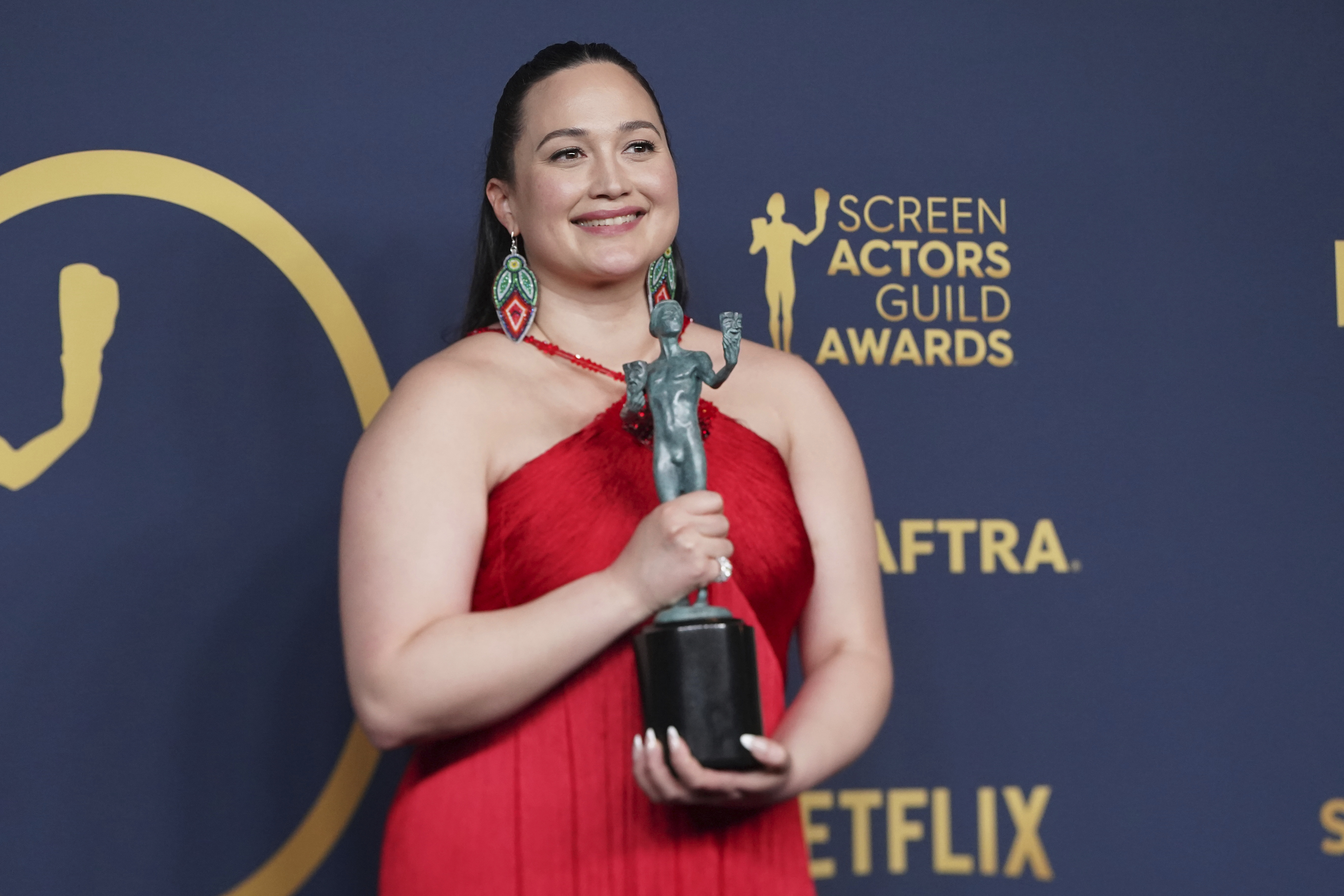Why this Lily Gladstone fan won’t see ‘Killers of the Flower Moon’
Native filmmaker discusses actor’s historic Oscar nomination, new wave of Indigenous storytelling, and his decision not to watch Scorsese epic

Lily Gladstone, winner of the award for outstanding performance by a female actor in a leading role for “Killers of the Flower Moon,” poses in the press room during the 30th annual Screen Actors Guild Awards on Saturday, Feb. 24, 2024, at the Shrine Auditorium in Los Angeles. (Photo by Jordan Strauss/Invision/AP)
AP photo
Native American communities across the nation are relishing Lily Gladstone’s historic feat as the first Native American to receive a Best Actress Oscar nomination for her role in Martin Scorsese’s “Killers of the Flower Moon.” Among the many rooting for her is Sky Hopinka, filmmaker and assistant professor at the Harvard Department of Art, Film, and Visual Studies, even though he has not seen the movie.
Based on the true story of a series of murders of Osage tribal members in Oklahoma during the 1920s for their oil-rich land, the film depicts the killings with such brutality that Hopinka chose against viewing it.
“Part of me understands the importance and significance of this history, and the fact that it’s been shared with an audience that isn’t familiar with it, but it’s a history that I’m familiar with,” said Hopinka, a member of the Ho-Chunk Nation. “I’ve seen enough Native people in cinema being killed and murdered by white settlers. I know this history. I know what happens. I know how it ends.”
I know this history. I know what happens. I know how it ends.
Gladstone, who stars as Mollie Burkhart, an Osage woman at the center of the saga of greed and betrayal, has acknowledged that the film’s depictions of violence could be disturbing. In a social media post, she advised Native women and youth to see the movie “when and only if you feel ready,” and warned them of “the generational grief” they might need to process.
An experimental filmmaker and a 2022 winner of the MacArthur Fellowship, Hopinka has followed Gladstone’s career and is a fan of her work, which includes the 2016 film “Certain Women” and “Fancy Dance,” a 2023 movie directed by Native American filmmaker Erica Tremblay.
“I’m rooting for her, and I hope that she wins,” said Hopinka. “Lily Gladstone is an amazing actress, and the work that she’s done in other films is outstanding. I’m very happy that she’s getting this recognition.”
Gladstone’s Oscar nomination represents a recognition of her talent, said Hopinka, but it also highlights the importance of having Native American actors playing Native American characters, which lends authenticity and complexity to their portrayals. Gladstone, of Siksikaitsitapi and Nimiipuu heritage, grew up on the Blackfeet Reservation in Montana until she was 11 years old, when she and her family moved to Seattle.
Some critics see “Killers of the Flower Moon” as the latest chapter in the evolution of Native American representation on the screen, from early portrayals in Western movies as enemies or villains to depictions as victims in white savior movies. “Dances with Wolves,” which won seven Oscars in 1991, is an example of a film with a white savior trope, said Hopinka. “This is a film where Kevin Costner became more Indian than the Indians and saved them or tried to.”
Outside Hollywood, a new wave of independent films and TV shows depicting contemporary Native life has emerged in the past few decades, including “Powwow Highway” (1989), “Smoke Signals” (1998), and more recently, “Reservation Dogs” (2021-2023), co-created by Sterlin Harjo and Taika Waititi, a coming-of-age story featuring four Indigenous teenagers on an Oklahoma reservation. The series, which earned a 2022 Peabody award, featured an all-Indigenous cast and crew.
“In the last decade there has been more space for Native filmmakers to make films about their own lives and the way that they exist in this world, and what it’s like to be an Indigenous person in America,” Hopinka said. “Native filmmakers such as Harjo, Tremblay, and others are doing amazing work and getting supported by mainstream media. The thing to keep in mind is that even if there isn’t another Native film that’s produced in a mainstream context in the next few years, there’s still filmmakers doing that work and [they] will continue to do that work in spite of and because of this success.”
By highlighting the Osage murders, “Killers of the Flower Moon,” based on a book by journalist David Grann, illuminates a chapter of American history that has been nearly erased or silenced, and more broadly, the historical mistreatment of Indigenous peoples in the U.S., said Hopinka. The film has picked up 10 Oscar nominations and has been hailed by critics as a “heartbreaking masterpiece.”
Hopinka hopes that Gladstone’s success will help inspire a younger generation of Native filmmakers and actors who can tell and portray their stories with authenticity and nuance. In January, Gladstone won a Golden Globe actress award, and in late February she won a Screen Actors Guild actress award.
“My hope is that the success of Lily, Sterling and all these other writers, filmmakers, and actors inspires the next generation to keep on telling their stories,” said Hopinka. “There is no universal Native American experience in this country. It varies by region, by tribe, by community. The more voices that are telling the stories that are unique to them, the more of an understanding we’ll all get to what it’s like to be a Native in this country and what it’s like to be a Native in the future.”




